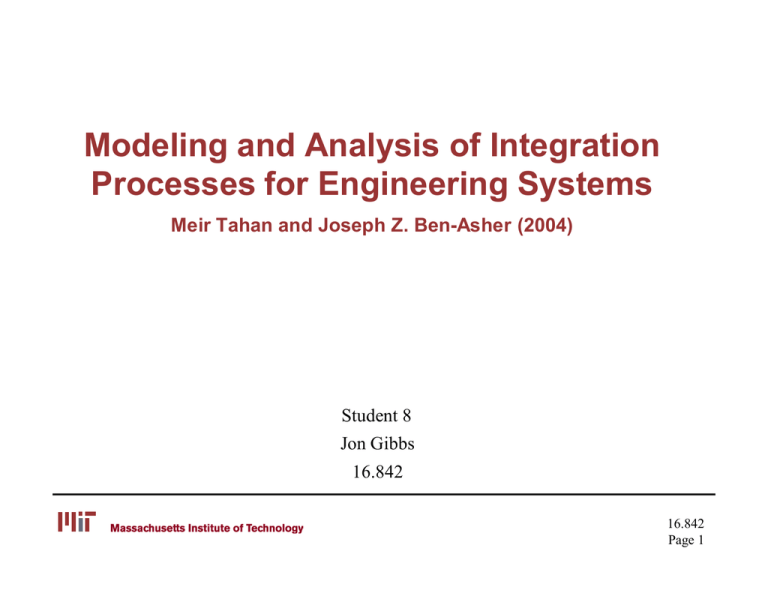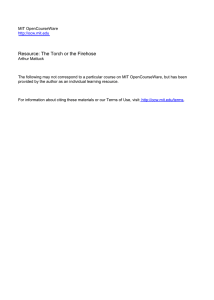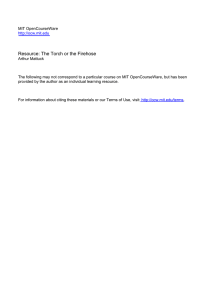Document 13356106
advertisement

Modeling and Analysis of Integration Processes for Engineering Systems Meir Tahan and Joseph Z. Ben-Asher (2004) Student 8 Jon Gibbs 16.842 16.842 Page 1 Types of Integration • Single Stage – Small number of subsystems – Assumes subsystems acquired simultaneously • Incremental – System too complex for single stage – Subsystems can arrive independently – Multiple methods – Typically have associated time and cost benefits 16.842 Page 2 Large Scale System Development Issues • Subsystem Development – Synchronizing Tasks • System Development – Integration of Subsystems • System Performance – Verification 16.842 Page 3 Relationship Strengths 4 Types of Flow: Information, Energy, Material, Physical • Degree 0: No significant relationship • Degree 1: One type of flow only • Degree 2: Significant flow of two types • Degree 3: Significant flow of three types Sharman and Yassine [2004] 16.842 Page 4 Case Study - UAV • Four UAV subsystems 1. Engine 2. Flight control 3. Optronic payload 4. Payload control • How should these systems be integrated? 16.842 Page 5 Single Stage Integration Single-stage integration. 1 Act1 0 2 0 Act2 0 Act3 0 7 d*Int12 8 d*Int34 9 Int1234 10 3 0 Act4 4 Image by MIT OpenCourseWare. Adapted from Figure 2 on p. 65 in Tahan, Meir, and Joseph Z. Ben-Asher. “Modeling and Analysis of Integration Processes for Engineering Systems.” Systems Engineering 8, no. 1 (2005): 62-77. • Subsystems prepared for integration • Tightly coupled subsystems integrated separately • Final systems integration of integrated subsystems • Total Time: Max(t1, t2, t3, t4) + d*t1,2 + d*t3,4 + t1,2,3,4 16.842 Page 6 Incremental Integration Incremental integration. Act1 Act2 0 5 0 Act3 Act4 6 0 q,Int34 8 d*Int12 9 S 0 p,Int12 0 7 Int1234 10 d*Int34 q=1-p Image by MIT OpenCourseWare. Adapted from Figure 3 on p. 65 in Tahan, Meir, and Joseph Z. Ben-Asher. “Modeling and Analysis of Integration Processes for Engineering Systems.” Systems Engineering 8, no. 1 (2005): 62-77. • Subsystems prepared for integration • First set of tightly coupled subsystems ready for integration triggers integration start • Assumes that remaining two subsystems ready after first set is integrated • Integration of all subsystems then performed • Total Time: Min of [Max(t1,t2), Max(t3,t4)] + t3,4 + d*t1,2 + t1,2,3,4 16.842 Page 7 Success Probability Summary of the probabilities of sucess in meeting the time requirement Case 1 Case study Case 2 d 0.8 1.0 1.2 0.8 1.0 1.2 Single stage 1.000 1.000 0.257 1.000 0.770 0.116 Incremental 1.000 1.000 0.949 1.000 0.998 0.853 Image by MIT OpenCourseWare. Adapted from Table 2 on p. 68 in Tahan, Meir, and Joseph Z. Ben-Asher. “Modeling and Analysis of Integration Processes for Engineering Systems.” Systems Engineering 8, no. 1 (2005): 62-77. • Incremental integration has higher probability of success • Single stage integration will perform poorly with complex systems 16.842 Page 8 Types of Incremental Integration • Option A: Single Stage Minimize Total Integration Time – Ts=Max(t1,t2,t3,t4) • Option B: Integrate first available units: t1 – Ts =Min[Max(t1,t2),Max(t3,t4)] Then integrate other units in order of t2 5 0 t3 6 0 0 q,t34 8 d*t12 9 S p,t12 7 t1234 10 d*t34 t4 arrival Option C: Integration in pairs followed by full Image by MIT OpenCourseWare. Adapted from Figure 4 on p. 66 in Tahan, Meir, and Joseph Z. Ben-Asher. “Modeling and Analysis of Integration Processes for Engineering Systems.” Systems Engineering 8, no. 1 (2005): 62-77. system integration Option D: Integrate the first pair then integrate all available units 16.842 Page 9 Incremental Options C & D • Option C • Option D • (1) Integrate first available • (1) Assume a simulator for unit 1 – Min[Max (t1,t2),Max (t3,t4)] • (2) Integrate in pairs – (t1,2,t3,4), • (3) Full systems integration – (t1,2,3,4) • Ttot=Min[Max (t1,t2),Max (t3,t4)]+t3,4+t2,3+t1,2,3,4 – Min[t2,Max (t3, t4)] • (2) Integrate remaining pairs with some difficulty – d*t3,4 or d*t1,2 • (3) Full systems integration • Ttot=Min[t2,(Max (t3,t4)+t1,2]+d*t3,4+t2,3+t1,2,3,4 16.842 Page 10 Results • Difficulty Factor mainly determines break even point 0.1 Tot 0.05 .43 • Replacement time of simulator can be traded with difficulty factor to decide which method has the fastest expected time .23 0 145 150 155 160 w B 165 170 175 D Image by MIT OpenCourseWare. Adapted from Figure 10 on p. 73 in Tahan, Meir, and Joseph Z. Ben-Asher. “Modeling and Analysis of Integration Processes for Engineering Systems.” Systems Engineering 8, no. 1 (2005): 62-77. P success [%] 50 40 Option D 30 20 Option B 10 0 0 5 10 15 20 25 X[%] • Many firms know the replacement time of a simulator with more certainty than component completion times Image by MIT OpenCourseWare. Adapted from Figure 11 on p. 74 in Tahan, Meir, and Joseph Z. Ben-Asher. “Modeling and Analysis of Integration Processes for Engineering Systems.” Systems Engineering 8, no. 1 (2005): 62-77. 16.842 Page 11 Decision Considerations • Single Vs. Incremental – Consider level of complexity • Simulator: – Consider replacement time and level of uncertainty – Cost of test equipment and labor • Type of incremental integration – Knowledge of PDF for each method 16.842 Page 12 Very Light Jet Case Study • Is it faster to prototype or not? • Approach 1) Obtain FAA approval first, make changes, tackle manufacturing learning curve after • Approach 2) Prototype first and tackle manufacturing learning curve, obtain FAA approval second, make certification changes last • Three Variables: Tlc,Tfaa,d*Trework 16.842 Page 13 Conclusions • Incremental integration almost always requires less time than single stage integration • Incremental integration may be required for complex systems • Multiple levels of incremental integration exist 16.842 Page 14 Integration Example – Boeing 787/GEnX • Six Primary Modules • Fan, LPC, HPC, Combustor, HPT, LPT Image by MIT OpenCourseWare. 16.842 Page 15 Boeing 787/GEnX Integration • Aircraft and engines are typically developed in parallel at separate companies and with minimal final integration (relative to aircraft/engine design). What allows this incremental integration to occur? • Aircraft engine design is typically divided into modules (subsystems). One could argue that the relationship between modules is both tightly and weakly coupled. Why? 16.842 Page 16 Discussion Questions • Many of the incremental integration models do not assume a particular path, but rather perform sub-system and system integration when the inputs are available. Is there a benefit from planning a target path for integration? • The paper presents a decent back-to-back study of single stage and incremental integration through various modeling techniques. Is there a benefit for a program to evaluate the integration methodology using these techniques? If so, would the result be quantitative or just qualitative? • What level of simulator accuracy is required for incremental integration? 16.842 Page 17 MIT OpenCourseWare http://ocw.mit.edu 16.842 Fundamentals of Systems Engineering Fall 2009 For information about citing these materials or our Terms of Use, visit: http://ocw.mit.edu/terms.






